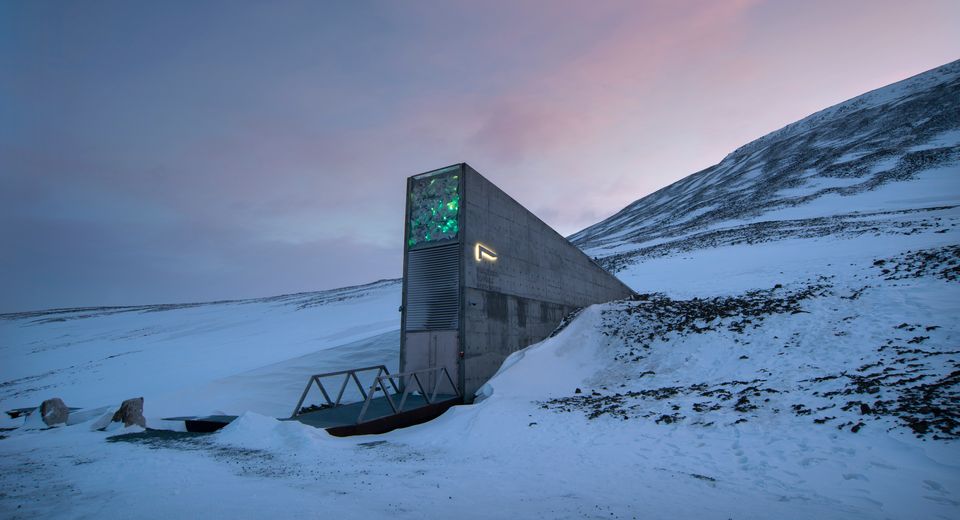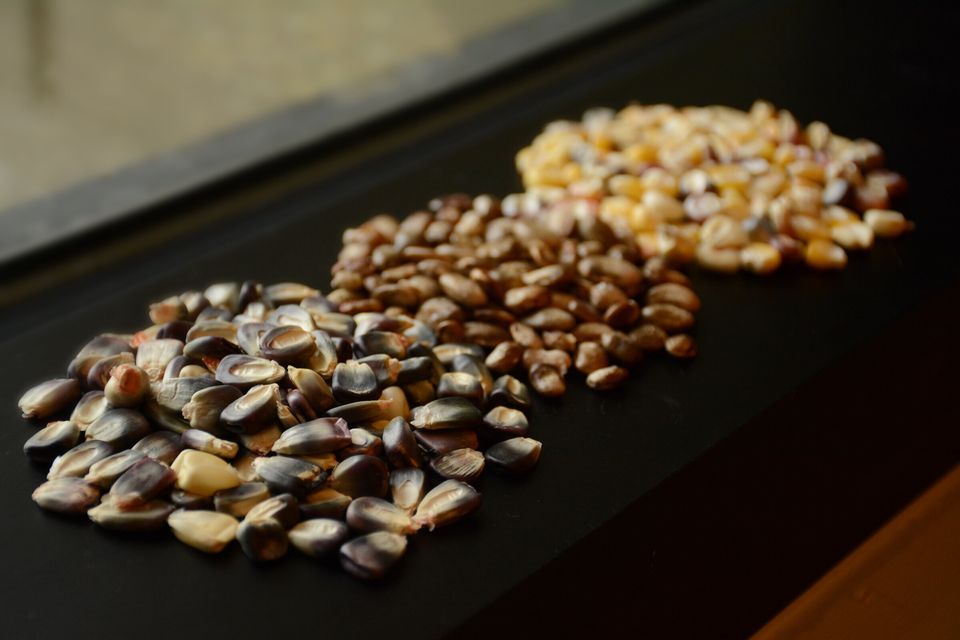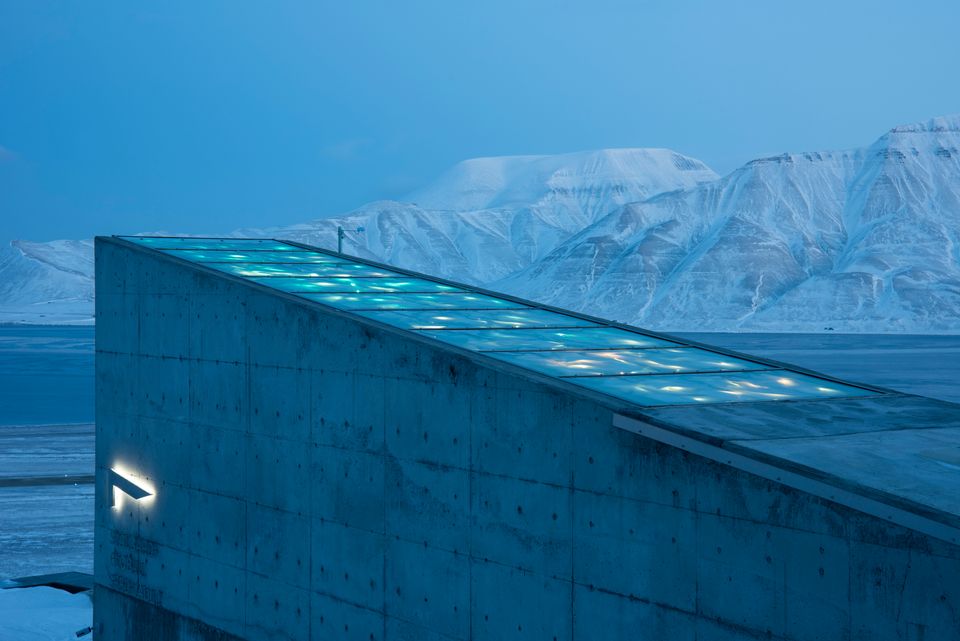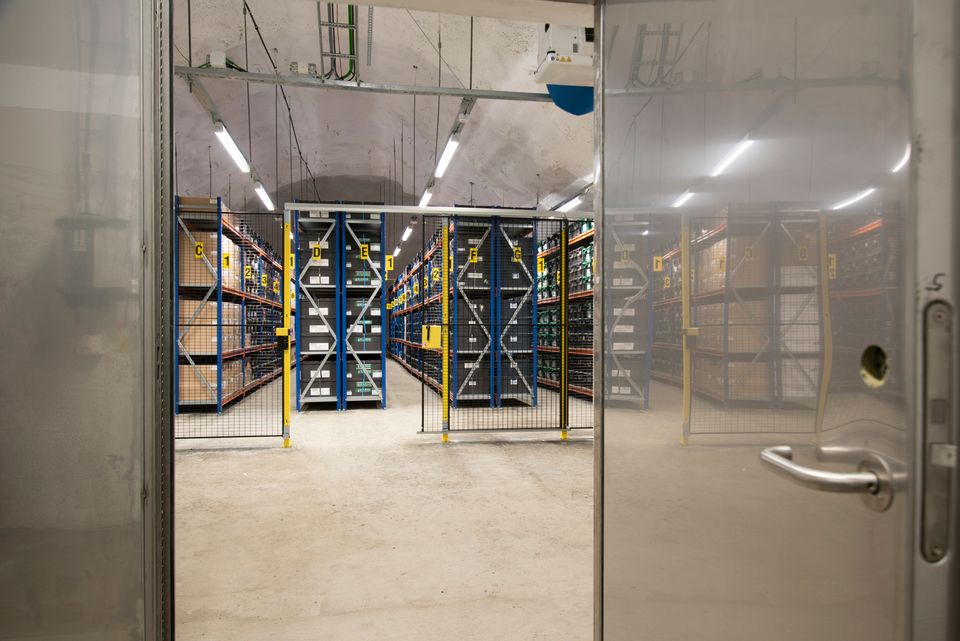The “Doomsday Vault” lies within the Arctic Circle on the island of Spitsbergen, about halfway between mainland Norway and the North Pole. All that can be seen from outside the vault is the entrance ― a futuristic jut of concrete, illuminated with blue-green fiber optic lights. The rest of the building stretches into the mountainside, sunk deep into the rock and permafrost to keep temperatures low. It is designed to remain at -0.4 degrees Fahrenheit (-18 degrees Celsius), even without power. It’s supposed to outlast humanity.
The vault was built to conserve something invaluable: seeds. Officially known as the Svalbard Global Seed Vault, this is a backup facility for the 1,700 seed banks around the world. It’s a library of diversity and a time capsule of agricultural history, designed to safeguard the world’s most important crops from catastrophe ― including war, disease and, increasingly, the impact of climate change.
“Just like you have your computer and you want to back up your hard drive and make sure that your data is at another location ― that’s the purpose of the seed vault at Svalbard,” said Hannes Dempewolf, senior scientist at the Crop Trust, the international nonprofit that manages the seed vault together with the Norwegian Ministry of Agriculture and Food and the Nordic Genetic Resource Centre (NordGen).
The vault now holds seeds representing more than 5,000 species, provided by local seed banks from nearly every country in the world. The aim is to store a copy of every unique seed that currently exists in the global network of seed banks.

This month will see the largest deposit of seeds in the vault since it opened in 2008, with 36 seed banks storing samples on Tuesday, bringing the total number of seeds inside the vault to just over one million.
Among them is the Cherokee Nation, the first US-based tribe to deposit seeds in the vault. The Svalbard Global Seed Vault approached the Cherokee Nation after reading an NPR story about the tribe’s program to conserve important seeds and distribute them to Cherokee Nation citizens across the US and overseas.
The tribe has selected nine seeds for the vault, including Cherokee white eagle corn, yellow flour corn, long greasy beans, Trail of Tears beans and candy roaster squash. These were identified as having the most historical value and as being the most popular requests from the tribe’s seed bank.
“It’s a great honour,” said Chuck Hoskin Jr., principal chief of the Cherokee Nation, of making the Svalbard seed deposit. “It says something about the strength and endurance of the Cherokee Nation. We’re talking about plants that predate European contact. We’re talking about plants that helped sustain us as the United States and white settlers were encroaching on our lands.”

Hoskin said seeds for these plants were carried with the Cherokee people when, in 1838, they were forced to move from their lands in the Southeastern United States to a new homeland in Oklahoma ― a brutal eviction that became known as the “Trail of Tears.”
Very little is known about the cultural significance of many of the oldest seeds housed in seed banks, said Dempewolf, which is what makes the Cherokee Nation’s deposit particularly exciting for the Svalbard vault. “The Cherokee Nation have cherished a lot of the varieties that they’re depositing now for hundreds of years, if not millennia,” Dempewolf said, adding, “There’s so much cultural history and story connected to those seeds.”
For Hoskin, there are mixed emotions. It’s a testament to the resilience and importance of the Cherokee that they are contributing to the world’s knowledge of seeds and foods, he said. On the other hand, he said, “we know that if the Global Seed Vault is ever opened for use, that it’s because of a world catastrophe and I think the most alarming catastrophe that could befall the Earth is the impacts of climate change.”

The vault was constructed as an insurance policy against all manner of catastrophes ― manmade or natural ― but climate change increasingly seems to be making the most compelling case for its existence. Climate change is driving up air and ocean temperatures, distorting ecosystems and triggering destructive feedback loops. And biodiversity is paying a heavy price.
A landmark United Nations report last year found that up to one million land and marine species could go extinct over the next decade.
While we are beginning to feel the grief of losing animal species, we are perhaps less aware of the impact of losing plant species. “That is an irrevocable loss,” said Dempewolf. It’s not only the foods the plants produce and the link to cultures that disappear. We also lose an essential weapon in the fight against the climate crisis: diversity.
Just three crops ― rice, wheat and corn ― account for more than 50% of the world’s plant-derived calories, according to a 2017 report from the research organisation Bioversity International. This lack of diversity leaves our food systems hugely at risk from disease and climate change. Meanwhile, traditional seed varieties with traits that make them more resilient to climate change are being lost.
“We should also be raising the alarm for our disappearing agrobiodiversity,” M. Ann Tutwiler, then director-general of Bioversity International, wrote in The Guardian in 2017. “After all, if there is one thing we cannot allow to become extinct, it is the species that provide the food that sustains the seven billion people on our planet.”
That is the purpose of the Svalbard vault. “Every single seed in the Svalbard Global Seed Vault holds potential solutions for sustainable agriculture ― solutions that are vital for feeding a growing population and achieving a green transition,” said Lise Lykke Steffensen, executive director at NordGen.

The vault itself, located in the fastest-warming area of the planet, is not immune to the changing climate. In 2016, a warm Arctic summer led water from melting permafrost to breach the entrance of the vault. The water did not make its way to the seed vaults, but it was a clear warning that the vault was not as impregnable as thought.
A $21.6 million (20 million euros) upgrade, including a new waterproof access tunnel, was completed in 2019. It is “a safe and secure facility now,” said Dempewolf.
Tuesday’s seed deposit is the first to be made since the upgrade. “The large scope of today’s seed deposit reflects worldwide concern about the impacts of climate change and biodiversity loss on food production,” said Stefan Schmitz, executive director of the Crop Trust, “but more importantly it demonstrates a growing global commitment … to the conservation and use of the crop diversity that is crucial for farmers in their efforts to adapt to changing growing conditions.”
For the Cherokee Nation, the significance is also personal. “The seeds are very much a symbol of Cherokee strength, grit and endurance,” Hoskin said. “And the fact that the seeds are still with us, are still grown by our people, and are now recognized by a world body as being indispensable to the future of the planet, I think that speaks highly of the Cherokee people.”
For more content and to be part of the “This New World” community, follow our Facebook page.
HuffPost’s “This New World” series is funded by Partners for a New Economy and the Kendeda Fund. All content is editorially independent, with no influence or input from the foundations. If you have an idea or tip for the editorial series, send an email to thisnewworld@huffpost.com.